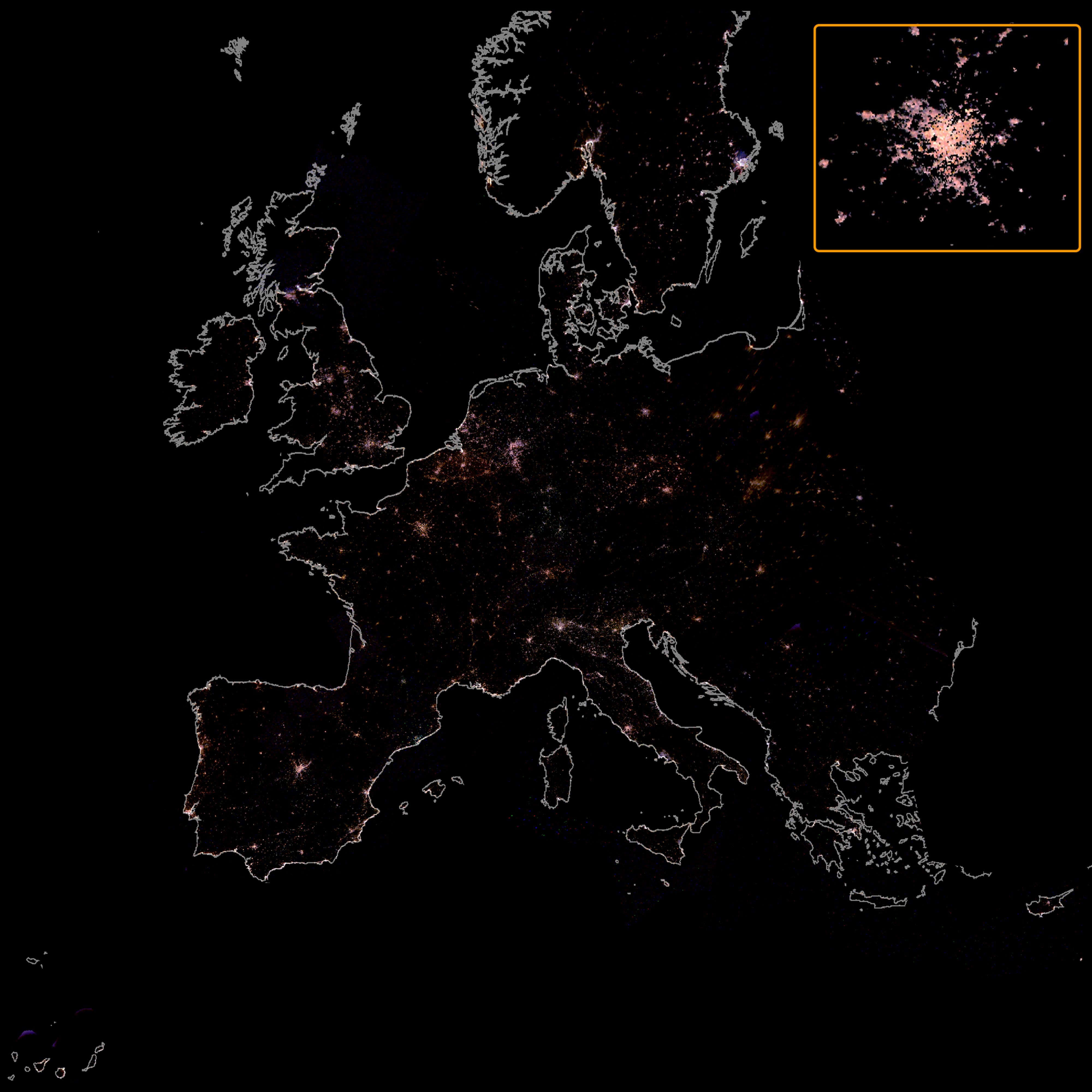Reactions to study showing that artificial light is increasingly emitting blue spectra associated with LEDs
Using images taken by astronauts aboard the International Space Station, a team of researchers has designed a map showing the variation in the spectral composition of artificial lighting across Europe during 2012-2013 and 2014-2020. The results, published in the journal Science Advances, show a change associated with white LED lights and higher blue emissions, which the authors link to an increased risk of harmful effects on ecosystems.

Map of Europe at night for the period 2014-2020 created from images taken from the International Space Station with Nikon D3, D3S, D4 and D5 DSLR cameras. Paris is shown in the inset above. Author: Sánchez de Miguel et al., Sci. Adv. 8, eabl6891 (2022).
Jaime Zamorano - luces artificiales EN
Jaime Zamorano
Professor of the Department of Earth Physics and Astrophysics at the Faculty of Physical Sciences of the Complutense University of Madrid
We are witnessing the replacement of our city and road lighting from high-pressure sodium lamps (HPS) to LED luminaires. While the former are orange in colour, the new ones are mostly white because of their blue component in the spectrum. Switching to LEDs is motivated by energy savings and is an opportunity to reduce light pollution if the new luminaires are designed to illuminate more efficiently and low blue LEDs are used.
Night-time images of the Earth obtained by artificial satellites show the location and intensity of artificial lights. Their analysis makes it possible to assess the increase in extent and brightness. However, these satellites were not designed to study light pollution and are, for example, blind to light emission in the blue region of the spectrum. Therefore, changes in the colour of artificial light sources caused by the onslaught of the switch to LED technology are not recorded. As a result, the estimation of the evolution of light pollution with these measures is not correct. We need blue-sensitive and colour-distinct images such as photographs from digital cameras working in RGB.
The scientific use of night-time photographs obtained from the International Space Station was presented in the thesis of Alejandro Sánchez de Miguel (UCM, 2015). The analysis of these images makes it possible to estimate both the brightness and the colour of the luminaires. In the work now published, a mosaic of calibrated images covering Europe is shown. The authors can then estimate the colour evolution of the change in lighting technology and, importantly, estimate some of the environmental impacts of the increase in the blue component. As expected there is a measurable shift to bluer luminaires. The transformation of these colour images into environmental impact maps indicates that the risk of harmful effects on ecosystems is increasing.
Conflict of interest: the thesis of Alejandro Sánchez de Miguel, lead author of this study, was supervised by Jaime Zamorano, who is co-author of articles with some of the other authors of this work.
Anna Palomar - luz artificial EN
Anna Palomar
Predoctoral researcher at the Barcelona Institute for Global Health (ISGlobal) whose thesis deals with circadian disruption in part as a result of exposure to artificial light at night and its effects on human health
The circadian clock regulates the correct functioning of multiple systems in the human body. The main synchronising factor of this system is the light that enters our eyes through the retina. Blue light, that with a spectrum of 380-450 nm, is the most effective in synchronising (or altering) this system. The systemic shift to mainly LED street lighting has been promoted in many European cities to reduce environmental impact. However, little is known about the change in light colour of this new street lighting and its impact on human and planetary health.
The study by Alejandro Sánchez de Miguel et al. highlights the shortcomings of previous studies that have assessed the increase in artificial night-time lighting using night-time images, but without taking into account the colour of the light emitted, so estimates may have been underestimated. In the present work, the authors have used images taken from the International Space Station with cameras that provide information on light colour and have shown an increase in artificial light levels, especially blue light, in Europe following the widespread switch to LEDs.
The study highlights the importance of assessing the impact of exposure to artificial light at night, especially in the blue spectrum. In addition, the authors of the paper also highlight the footprint that this increase in blue light may have not only for humans but also for many other species. The article demonstrates this progressive increase in blue light levels in European cities, although more studies are needed to assess its effects on human health and to propose preventive measures.
Alejandro Sánchez de Miguel et al.
- Research article
- Peer reviewed
